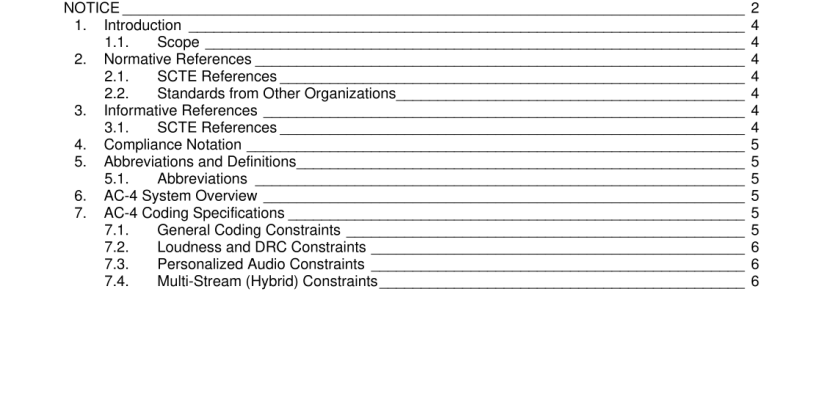ANSI SCTE 242-2-2017 pdf download.Next Generation Audio Coding Constraints for Cable Systems
1.1. Scope
This document is part two of a three-part standard that specifies the coding constraints of Next Generation Audio system for cable television. In conjunction with SCTE 242-1 2017 [1], this document defines the coding constraints on AC-4 for cable television. The carriage of the streams described in this specification is defined in SCTE 243-2 2017 [9] in conjunction with SCTE 243-1 2017 [8].
2. Normative References
The following documents contain provisions, which, through reference in this text, constitute provisions of this document. At the time of Subcommittee approval, the editions indicated were valid. All documents are subject to revision; and while parties to any agreement based on this document are encouraged to investigate the possibility of applying the most recent editions of the documents listed below, they are reminded that newer editions of those documents might not be compatible with the referenced version.
3. Informative References
The following documents might provide valuable information to the reader but are not required when complying with this document.
4. Compliance Notation
shall This word or the adjective “required” means that the item is an absolute requirement of this document. shall not This phrase means that the item is an absolute prohibition of this document. forbidden This word means the value specified shall never be used. should This word or the adjective “recommended” means that there may exist valid reasons in particular circumstances to ignore this item, but the full implications should be understood and the case carefully weighted before choosing a different course. should not This phrase means that there may exist valid reasons in particular circumstances when the listed behavior is acceptable or even useful, but the full implications should be understood and the case carefully weighed before implementing any behavior described with this label. may This word or the adjective “optional” means that this item is truly optional. One vendor may choose to include the item because a particular marketplace requires it or because it enhances the product, for example; another vendor may omit the same item. deprecated Use is permissible for legacy purposes only. Deprecated features may be removed from future versions of this document. Implementations should avoid use of deprecated features.
5. Abbreviations and Definitions
6. AC-4 System Overview
AC-4 is a highly efficient audio codec that supports legacy channel-based content, object-based and channel-based immersive content, personalized content, and advanced metadata as defined in ETSI TS 103 190-2 [6]. A complete description of the AC-4 system features is available in ATSC A/342 Part 1 [2] section 5.1 and A/342 Part 2 [3] section 4.
7. AC-4 Coding Specifications
AC-4 audio elementary streams shall comply with the syntax and semantics contained in ETSI TS 103 190-2 [6] , as well as the parts of ETSI TS 103 190-1 [5] referenced by ETSI TS 103 190-2 [6] , as constrained in the following sections.
7.1. General Coding Constraints
AC-4 audio elementary streams shall comply with the constraints defined in ATSC A/342 Part 2 [3], Section 5.2.
7.2. Loudness and DRC Constraints
In order to comply with the loudness recommendations in ATSC A/85 [4], AC-4 audio elementary streams shall comply with the constraints defined in ATSC A/342 Part 2 [3], Section 5.3.
7.3. Personalized Audio Constraints
In order to provide a consistent listener experience, AC-4 audio elementary streams shall comply with the constraints defines in ATSC A/342 Part 2 [3], Section 5.4.
7.4. Multi-Stream (Hybrid) Constraints
When AC-4 presentations reference audio elements that are contained in more than one elementary stream, the relevant AC-4 audio elementary streams shall comply with the constraints defined in ATSC A/342 Part 2 [3], Section 5.5.ANSI SCTE 242-2-2017 pdf download
